In the city of Trinidad, Cuba’s colonial fantasy comes alive. Walking the cobblestones of this architectural jewel will wrap you in a tropical reverie.

However, besides Havana, Trinidad is synonymous with a Cuban vacation and therefore its own cliché. The traveller will find in an almost caricaturish way exactly what he expects. Consequently, Trinidad is a touristy epicenter and deems a bit void’n’shallow.
Trinidad s Past
Spanish conqueror Diego Velázquez de Cuéllar founded Trinidad in 1514. It was the third Spanish settlement after Baracoa and Bayamo. Initially, the Spaniards hoped to find gold in the nearby rivers. However, when the plans proved unrealistic, smuggling was the main trade well into the 18th century.
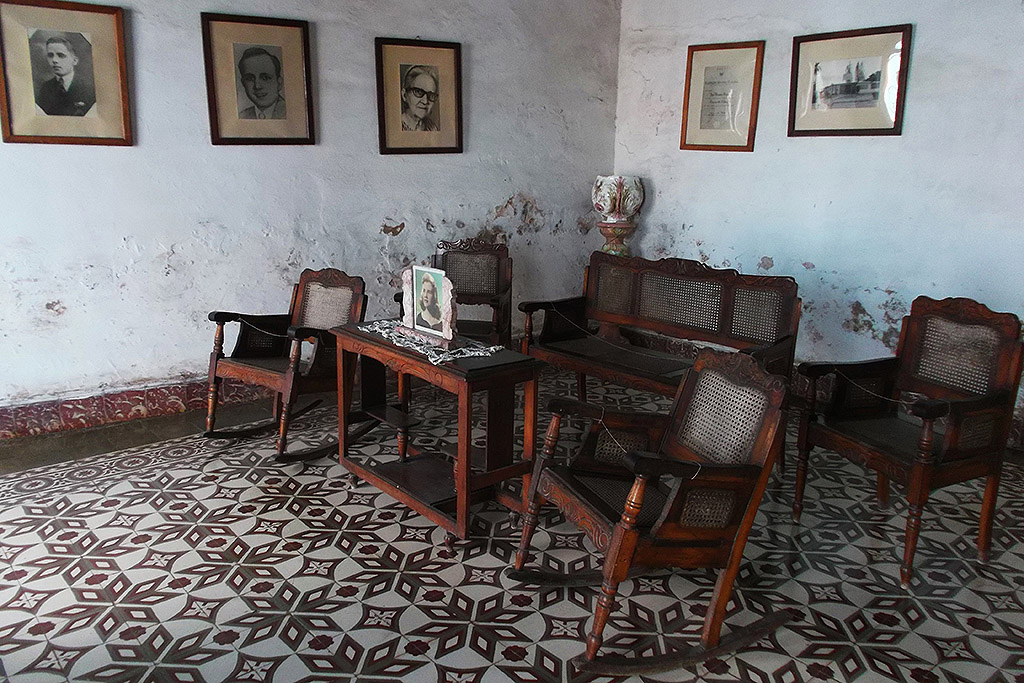
The city of Trinidad owes its rise to sugar and the connected slave trade.
Until the middle of the 19th century, Trinidad was one of Cuba’s most important sugar centers. Since also tobacco cultivation and cattle breeding were highly successful, between 1780 and 1830 the population quadrupled.
Sweets For My Sweet
The Valle de los Ingenios developed into the largest sugar cane plantations, where the Iznaga family of planters began building sugar mills in 1830. In 1846 sugar production peaked at 7700 tons.
At the end of the 19th century, sugar production from cane decreased drastically due to the increased cultivation of sugar beet in Europe. Consequently, the city’s blooming phase ended. Trinidad lost its supremacy in the region to neighboring Cienfuegos.

Trinidad sank into insignificance, but preserved its ancient streetscape and partly also the magnificent buildings around the Plaza Major.
Due to a new road between Cienfuegos and Sancti Spíritus, Trinidad experienced an upswing in the 1950s.

In the first half of the 1960s, the Sierra de Escambray, a few kilometers north of the city, was a refuge for counterrevolutionary groups. Today, it’s a popular destination for touristy excursions.
Trinidad s Present
Since 1988 the city has been a UNESCO World Heritage Site together with the sugar cane plantations of Valle de los Ingenios.
In Trinidad, there is beauty everywhere. However, one of the biggest tourist attractions is the Plaza Mayor.

There is this flair reminiscent of colonial times. All major museums are conveniently located around this square. The colonial center with a diameter of only about 600 meters has been largely preserved. Interestingly, most of the houses are inhabited.

On the south side of the square is a light blue building – hence, also known as the Casa Azul, the blue house – that houses the Museo de Arquitectura Colonial, and the Colonial Architecture Museum. As a matter of fact, it used to belong to the wealthy Sánchez Iznaga family and shows practically their belongings; so don’t expect a museum in the sense of….museum.
On its north side is the old Casa Padrón. Today, it houses the Museum of Archeology. On the east side is the Palacio Brunet, built in 1812 by José Mariano Borrell y Padrón and now housing the Museo Romántico, the Romantic Museum.

Adjacent is another neoclassical building that was completed in 1892, the Iglesia Parroquial de la Santísima Trinidad, Church of the Holy Trinity.
Don t You Miss It
So, go and walk the streets paved with cobblestones. See the colonial and brightly painted facades. Admire the antique shops filled with – you guessed so – antiques.
The evenings are very pleasant at the casa de la musica, however, mind you that many of the charming Cubans are jineteros, waiting for tourists to dance Salsa and get their drinks paid.
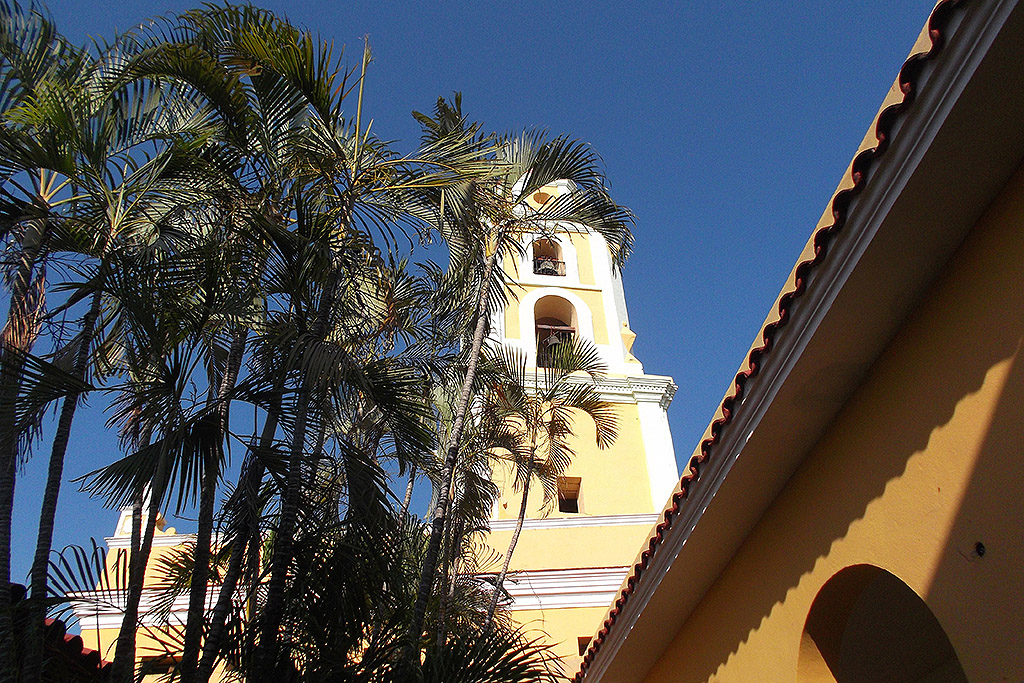
Make sure to climb the tower of the Convento de San Francisco de Asis to get a wonderful view of the city and its surroundings.

However, do it preferably either in the morning or in the later afternoon when at least the groups and day-trippers are gone. I’m not promising you to be there by yourself – ever; but at least all the pushy awers will be gone.

Being an art enthusiast, the building on the west side is my favorite. Here you find the Galería de Arte Universal Benito Ortiz which is far more than just an art gallery.
It’s rather a cultural center where also young artists find working spaces and the opportunity to exhibit their work. The exhibition of traditional lace handicrafts from Trinidad on the first floor is not to be missed.

If you are into antiques, the Calle Desengaño will be just perfect for you: Peeping left and right into houses, shops, and galleries, you’ll see the most amazing things.

Walking further north, you’ll get a glance at what real life in Trinidad is like since here live more of the Afro-Cubans who obviously do not get such a big share of the fat tourism cake.
Let’s Dance
Every Cuban city has a casa de la musica and a casa de la trova.

What makes Trinidad’s casa de la musica more pleasing is the fact that it’s not a casa but a court so that you enjoy the musica and your mojito in the fresh air with the moon and the stars above – and that’s pretty nice.

If you need more – and most of all more original – party time, check out the Discoteca Alaya which is actually located in a cave. It’s open every night from 11 p. m. to 3 a. m.
A very unique party experience.
Out of Trinidad
About 15 kilometers west of Trinidad is the Playa Ancon. Some say it’s wonderful, others find it to be Cuba’s worse beach. Find out for yourself by cycling on a rental bike. Good luck, it’s Cuba, hence it’s hot and the roads are…Cuban.

Nevertheless, there is also a shuttle bus. You can inquire about the exact hours at the Cubanacan office on calle Frank País.
Of course, there is also the option of going by cab, but then you should carpool with others.
Excursion destinations near Trinidad are the Topes de Collantes National Park in the Sierra de Escambray, the sugar cane valley Valle de los Ingenios, and the Ancón peninsula with sandy beaches and snorkeling opportunities.
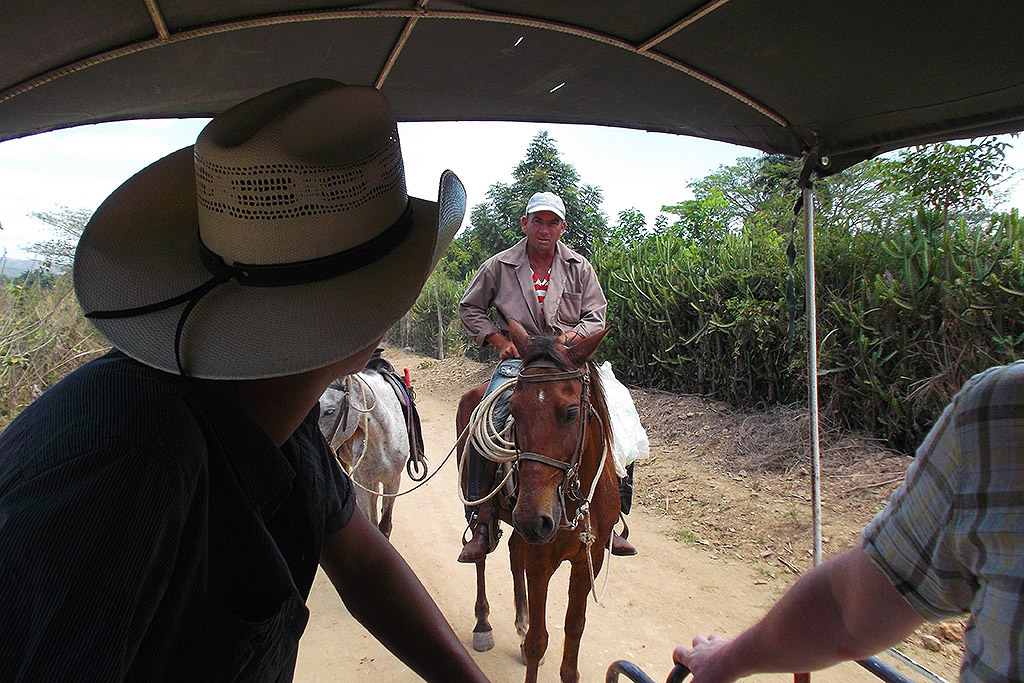
A really nice tour is a trip by cart and horse to the Valle de los Ingenios.

You get to climb to a waterfall and take a refreshing dip, you get to sample some ‘Guarapo’, juice pressed from sugar cane, and you learn a lot about the sugar cane history and industry in the region.
It’s a nice day out.
A Crazy Crime
I got robbed. And eventually, I unveiled an even bigger theft. These crimes happened in a quiet and at the same time quite touristy place in Cuba.

Establishing my private witness protection program, I will neither specify the place nor give you real names. Still, this story will let your blood run cold!
The Crime Scene
The very moment I stepped into the room, I felt there was something not right.
Casa Particular
In Cuba, when you do not want to stay at a hotel, and believe me, you do not want to stay at a hotel, because they are all run by the government, you book yourself into a Casa Particular.
While not every aspect of socialism is bad, when it comes to service and hospitality, it actually is. If you need something or have a request, never forget that employees at these places earn next to nothing and don’t give a damn. So what the savvy traveller does, is book her- or himself into a Casa Particular, a guesthouse run privately yet legally by some Cubans who can spare a room or two. Wonderful idea, a great project, good to get in touch with Cubans and Cuban life.

Usually, you get a medium-sized room with a heavy dark wooden bed, a mostly not matching nightstand, and some kind of closet with a funky mix of wooden, plastic, and wire hangers. The room is either lightened by an old, dusty chandelier or a simple lamp from the 70s. Often the hosts try to make it look homey by adding decorations like plastic flowers or stuffed animals of the tacky fairground style.
Although this sounds rather humble, you realize that in Cuba it’s the next best thing to a room at the castle of Versailles as soon as you see how your hosts live in most cases: definitely less comfortable.
A Typical Casa – Not
So after having spent a couple of nights in heavy dark wooden beds next to plastic flowers, you will understand my surprise when this particular host led me into a big, bright room.
I looked around with my mouth open: on a large, flat frame was a slightly smaller king-size mattress that left enough space around it to use the frame as a bed stand. At the ceiling – instead of grandma’s chandelier – were rows of embedded LED spots.
Where the hell did these people get all this stuff?
The host had a proud smile on his face when he saw my surprise and opened the matching closet – and as he opened the doors, lights went on and illuminated the closet’s inside – like in a fridge. Or like in a closet in a very classy hotel room.
“This is amazing! This is so elegant! It’s like a hotel room! A really posh hotel room!” I awed. He was shining with pride. “You’ll enjoy the best shower in all Cuba”, he promised, pointing at the bathroom door.
As I passed a sideboard, I noticed two water glasses, covered with paper lids that had the word sanitized printed on them. What’s going on here? Did these people actually order printed paper lids for their guests’ water glasses? Most Cubans own a couple of plastic cups – and these people sanitized glasses? Isn’t that a tad bit over the top for a Casa Particular?!
The shower, by the way, turned out to be one of these big, square rain shower thingies.
The Robbery
Then, two days later, I get out of my king-size bed, step into the glass cabin, and turn on the water that drizzles in sad drops from some of the holes in the square shower thingy. Unfortunately, Cuban water pressure doesn’t rise just because the gadget is posh.
As I wet my hair and squeeze the shampoo bottle, out comes a tired pfff and a small dab of shampoo. I’m irritated – the bottle was brand new when I got to Cuba. It should be still almost full.
I squeeze and squeeze – nope, almost empty.
How is this possible?
Irritated, I am drying myself and grabbed my body lotion. Hmm, the container seems so light. And the lotion, too, was purchased for the trip and should be almost full.
What is going on here?
I’m fixating on what might have happened to the stuff – and suddenly it hits me bolt: Someone emptied my toiletries! Someone robbed me! I’m aghast.
What are you supposed to do when someone steals your shampoo?
It’s ridiculous. Nevertheless, annoying.
And neither fair to me nor to the hosts.
I have to tell them.
The Interrogation
“Hola, Norman, ¿como estas, Luisa?” There they are, Norman with his worldly attitude who serves the breakfast treats as if he’s working on the Queen Elizabeth cruise ship. And his tiny wife Luisa who doesn’t get a certain agony and weariness out of her expression.
“I have a question: who is doing my room?”
“Me”, answers agonized Luisa, “why? Is something wrong?”
Oh, so she does. This is not what I expected to hear. Hence, this is going in the wrong direction. If there is one person in this town who did not siphon off my shampoo, then it’s this pathetic tiny person.
“Ummm, it’s only you? You alone?” Nodding.
“Umm, some of my shampoo is missing. Someone must have decanted it.” “It was not me!” She becomes agitated.
“It was not my wife!” Norman has her back.
Ok, what kind of dumbass do you guys think I am? Not one second did I suspect the landlady at this fancy place losing her reputation over shampoo.

But someone took it, and I don’t believe that nobody got into my room. They insist frantically that it’s only her having access to the room and they ask me over and over again if I’m sure, and I keep repeating to be sure and they keep repeating that they didn’t do it – which I’m sure of, anyway.
At some point, Norman goes to another room and comes back with a box full of small shampoo bottles, the size you buy for weekend trips or find in hotel bathrooms. “Look how much shampoo we have, we don’t need yours!”, he barks in my face.
“But I never thought it was you guys”, I repeat – meanwhile a little exhausted by this terribly embarrassing situation.
No More Shampoo….Please!
“You know what, forget it, it’s not that important”, I try to escape this shampoo hell. Meanwhile, Luisa has tears in her eyes and looks more miserable than ever. I go to my room to get ready as I hear someone knocking.
As I open the door, there is Norman standing with his arms full of shampoo bottles of all kinds of brands.
“Look what guests left with us: all this shampoo! We don’t need yours. Take one, take anyone you like” and he’s pressing shampoo bottles upon me. Ok, this is getting out of hand. I really have to control myself not to crack up laughing. This is absurd. Stop showing me shampoo! I don’t wanna hear about shampoo anymore.
“My wife is sick, she had to take pills for her blood pressure!” Ok, that’s enough.
I have a shampoo trauma and will never wash my hair again.
I need to get out of here.
The Special Unit
While I’m walking down the old colonial street paved with cute old cobblestones, I remember that the way to hell is said to be paved with good intentions.

It was with good intentions that I wanted to inform these two that someone is stealing at their house. However, it got me to shampoo hell!
Beats me why they insisted it wasn’t them and obviously didn’t even consider for a second the help hanging around the house. I bet she has access to the room, too, but I didn’t want to add fuel to the shampoo….um, flames.
Wandering around, I spot the English couple I’ve met some days ago in Cienfuegos sitting in front of a small diner having coffee and sandwiches. Now that I’m sort of a public enemy, it’s nice to see familiar faces. When travelling, it’s not unusual to meet the same people at every place you go over and over again. Most of the time, travellers go to the same spots.
Hello Neighbors
So anyway, since I’m in distress and they are nice, I tell them about the shampoo robbery and they are sympathetic and find I was absolutely right to tell the hosts about it.
“Where is it you stay?”, asks the English lady and I tell her Norman’s and Luisa’s names. “This is where we stay, too! Got there yesterday evening. We have the upstairs room”, she cheers – only to immediately turn a bit edgy. “Oops, we have all our stuff there. I left everything open…” “I wouldn’t worry”, I soothe her. “After today’s fuss, you’re stuff will never be safer. You don’t think that now that all eyes are on this situation someone will take something from your room, do you? What’s much worse is that his wife has a heart condition. If she dies from this, I will have killed her over shampoo!” We both giggle, and that lightens the mood a bit.
He’s A Pro
To make up for the calamity I caused, I now start to say nice things about our mutual hosts; how professional he prepares and serves the breakfast, and how nice everything looks. “Yap, he actually is a professional. He used to work at the Iberostar hotel. Didn’t you notice: the spoons and the other dishes have the Iberostar logo on them.”
No, I haven’t noticed. All I noticed was that everything is really very new and modern. The Brit’s room is not like that, though.
As I describe mine mentioning all the details, they are impressed and seem to be a little bit jealous. “Yes, it’s really fantastic”, I emphasize and describe the spots and the lights in the closet and the square – thus low pressure -shower and the lids on sanitized glasses.
“Like a hotel room”.
A Bad Penny Always Turns Up
“Maybe it is a hotel room….”, says the English lady.
We look at each other. My eyes are going wide and my jaw drops.
“Oh my god, you don’t think he…”, I stare at her in disbelief. Slowly remembering every bit, it dawns on me. The printed lids, the box full of miniature hotel shampoo bottles. All the especially for Cuba unusual state-of-the-art stuff. “You mean he got all that stuff from his former employer? Oh my god, and I told him ‘This is like a hotel room’…”
“So you were wrong: It is not like a hotel room, it is a hotel room! You are staying at an Iberostar room outside Iberostar!” She’s laughing. “How….?” I cannot even finish the sentence, this is hysterical!

“Well”, the English leans back and sketches the scenario coolly “they probably took a cart and a donkey and went there after dark. There’s an Iberostar just down the block. They didn’t even have to go far”.
I feel like such a naive fool that I didn’t suspect anything, even not when I saw the über-professional paper lids promising me the glasses would be sanitized. Wow, this is unbelievable!
In A Socialist Fashion
And then I remember that in Cuba, this might not be such a big deal. After all, Cuba is like a museum of the “real existing socialism”.
Almost thirty years ago, everybody in the former Eastern bloc lived like that. Here, the signs are still there. The queues in front of every bank, phone company, and almost empty stores.
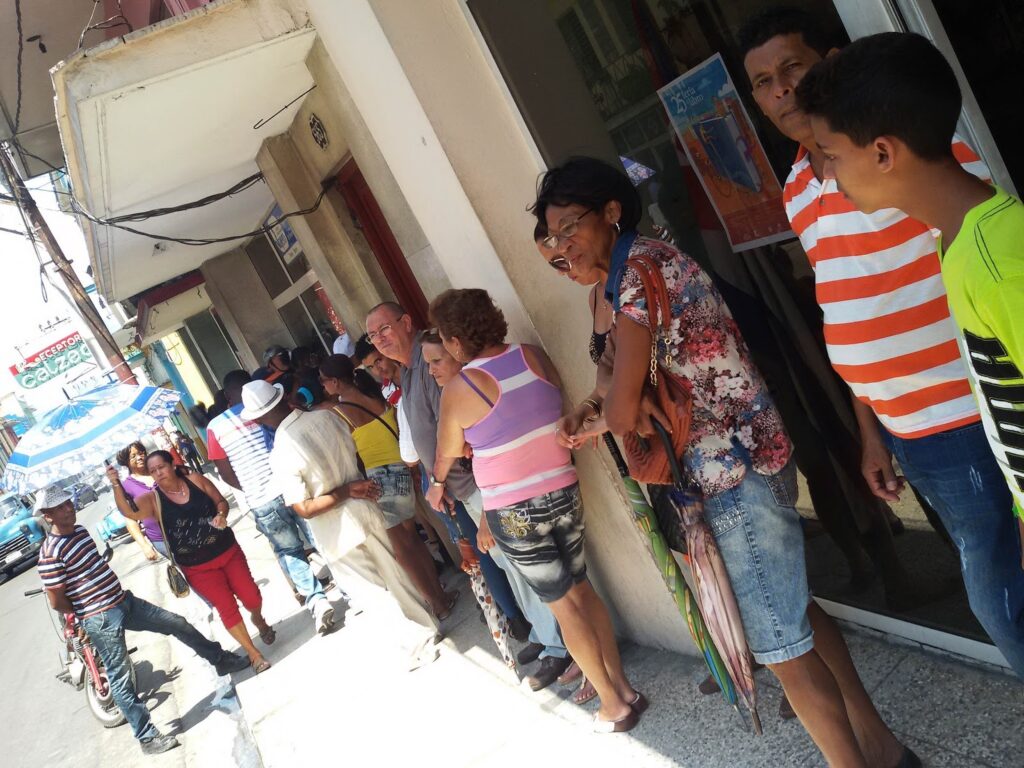
The oblivious or even rude employees at the government-owned businesses see no sense let alone challenge in being service-oriented. Finally, the refined art to obtain things that are officially nonexistent or not available. The term is not stealing, it’s called organizing.
Howsoever, someone is washing her sins away with my shampoo – organized from my room.
Practical Information
How to Get There and Around
The nearest airport to Trinidad is 60 kilometers away in Cienfuegos. However, your international flight will probably arrive at Havana or one of the touristy places such as Varadero.
By Bus
From there, you can continue to Trinidad for instance by Viazul. This company has a daily connection for instance from Havana as well as Varadero. Either ride takes about 6 hours. There are also cabs travelling this route and especially if you are carpooling, the price difference is almost none.
Especially when travelling by Viazul to or from a very touristy place like Trinidad, I’d recommend making a reservation as soon as your route and date are determined – the sooner the better.
The bus station is right in the city center of Trinidad so you’ll probably be able to walk there. However, my host sent a bicitaxi to pick me up. As the driver demanded 5 CUC for a distance I had walked in five minutes, I understood that it wasn’t a nice gesture or service, but that I got duped. ¡Bienvenidos en Trinidad!
Where to Stay and to Eat
I guess you’ll understand that after what happened to me in Trinidad, I won’t recommend the casa I stayed at – although the room was impressive.

This being said, Trinidad is so touristy that many, many locals are running Casas Particulares, so you won’t have to squat in the street. Because of Trinidad’s popularity, there are even international hotels to choose from.
Cash and Cards and Connection
There is an Etecsa Office at the Parque Céspedes in Trinidad as well as another sales point where you can obtain scratch cards. On this page, you’ll find ETECSA’s complete list of hotspots. To narrow it down, you need to choose Sancti Spíritus from both the dropdown menu Provincia and then Trinidad from the menu Municipio. This way, you’ll see all the places where you can access the internet.

Trinidad is a tourist and also a day-trippers hotspot so there are various banks and ATMs on Calle Jesús María.
Until the end of 2020, there were two official currencies: The CUP – Peso Cubano – and the CUC – Peso Convertible. The socialist island state has had this confusing dual currency system since 1994.
However, since the beginning of 2021, only the Peso Cubano keeps circulating. The exchange rate is 24 CUB to one US$. This unification of the currencies is expected to grant Cuba’s citizens equal opportunities and social justice.

Already in July 2020, Cuba had abolished the ten percent tax on US$ purchases that had been in force since 2004. Since then, in some shops, certain products can also be paid for by card in US currency.
Since this novelty is still in progress, obviously, some prices in my posts on Cuba still quote the Peso Convertible CUC – as do many Cuban websites. I hope that they’ll correct their sites asap so that I can adjust the information on my blog. However, if you don’t want to wait: One CUC equals one US$, so that shouldn’t be a big problem, after all.
Trinidad was only one of many fascinating places I’ve visited in Cuba. To read about the others, go to the main post and take your pick! There you’ll also find valuable general information that will make your trip smoother.
Pinnable Pictures
If you choose to pin this post for later, please use one of these pictures:

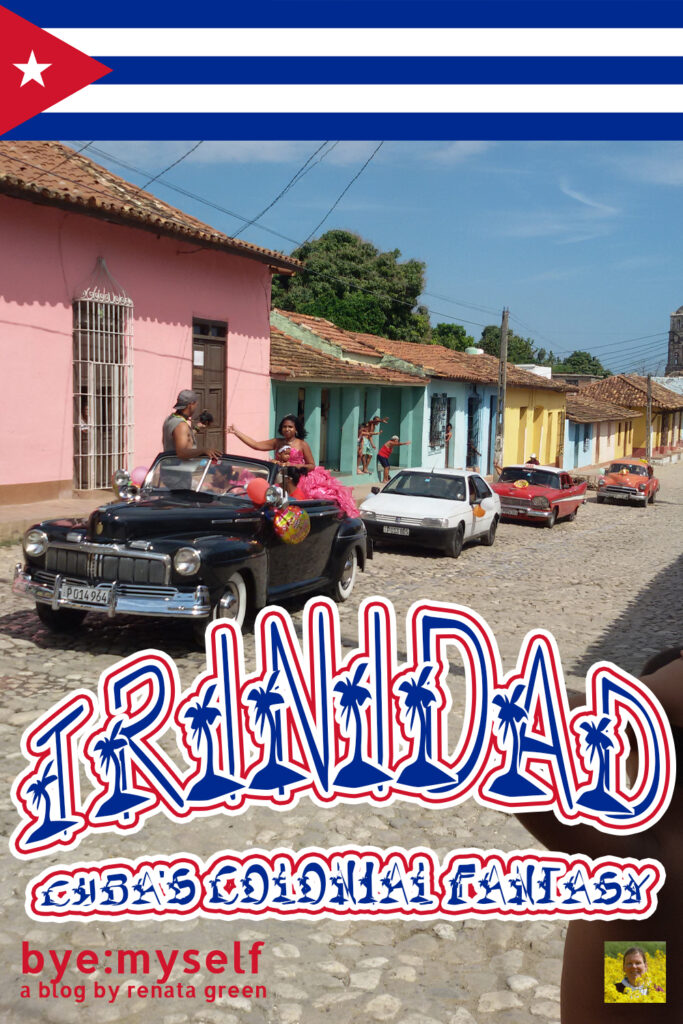



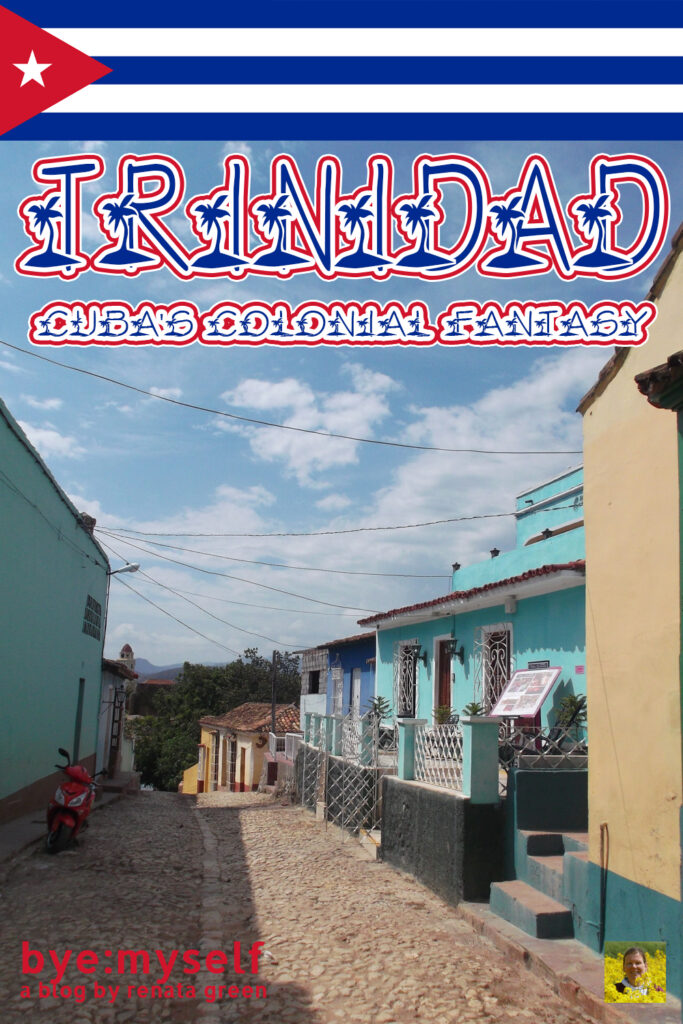
Did You Enjoy This Post? Then You Might Like Also These:
Grub First, Then Ethics – Brace Yourself for Cuba
Guide to CIENFUEGOS – the Fancy Side of Cuba
Guide to CAMAGUEY – Cuba’s Modest Beauty
Guide to BARACOA – Cuba’s Hidden Gem
Guide to SANTA CLARA – Reliving Cuba ‘s History
Guide to TRINIDAD – Cuba’s Colonial Fantasy
Guide to HAVANA – Welcome to the Club
Getting a Haircut Around the World
* This is an affiliate link. If you book through this page, not only do you get the best deal. I also get a small commission that helps me run this blog. Thank you so much for supporting me!





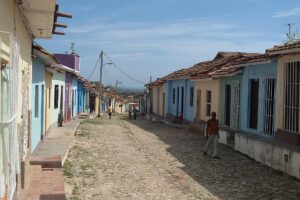


On most of our visits to Cuba, we headed for the beach and missed many of the towns in Cuba. We will have to plan to visit Trinidad when we finally get back to Cuba. It was be interesting to explore the sugar cane plantation. And wander through the beautiful town with the colourful facades. So sad that you had a bad experience with your toiletries.
For me, it was the opposite: I didn’t spend enough time on the beaches. The mess with the toiletries was pretty hilarious…in retrospect 😉
T he Caribbean ’s most fascinating country: a heady mix of faded Spanish colonial cities, sputtering Fifties Cadillacs, wonderful live music, world-class cigars and an arcane communist system. The recent thawing of relations between the United States and Cuba, and the consequent gradual easing of travel and trade restrictions, is another intriguing element in the complex set-up on Castro’s isle. On the downside, often things don’t work as they should or go to plan, and the service in hotels and the food, though improving, are not on a par with other Caribbean destinations.
You’re right – it can get a bit complicated and frustrating. I think that we simply shouldn’t compare Cuba to other countries only because it’s in the Caribbean. It’s very different – and that’s part of its charm, isn’t it?! 😉